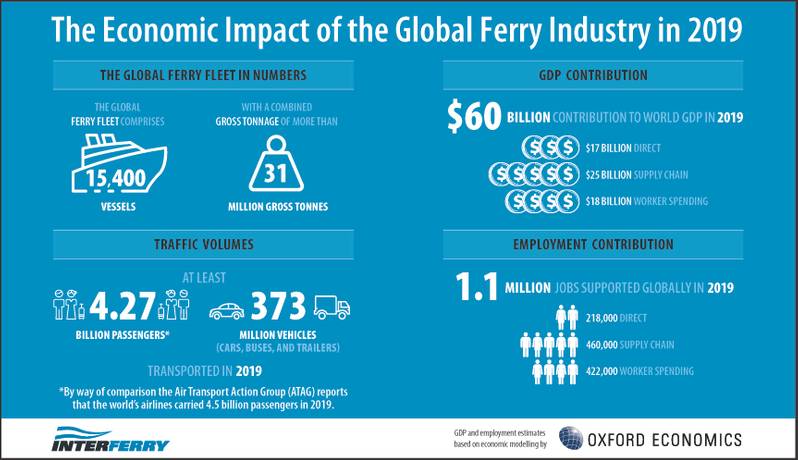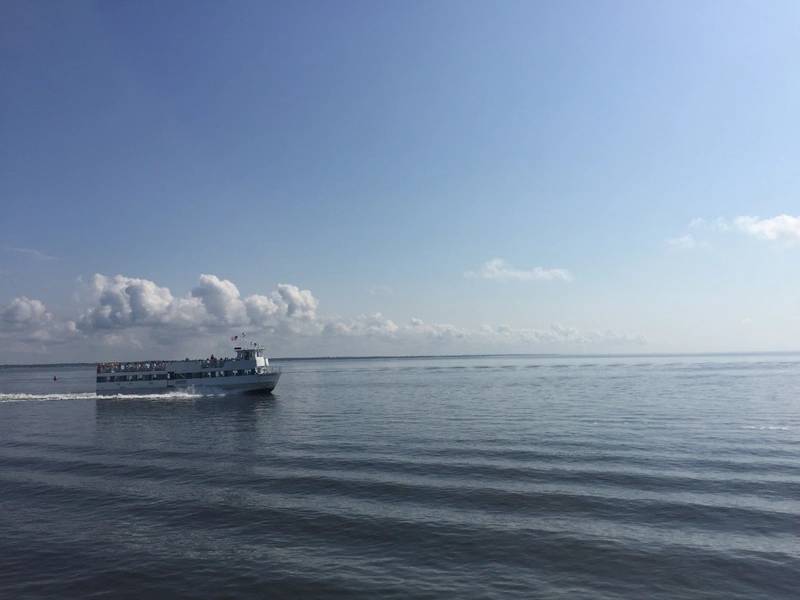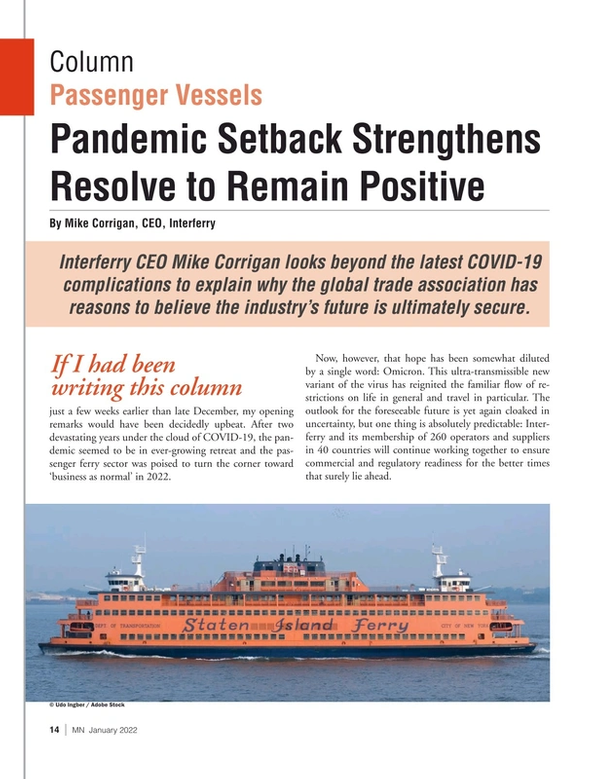
Pandemic Setback Strengthens Resolve to Remain Positive
Interferry CEO Mike Corrigan looks beyond the latest COVID-19 complications to explain why the global trade association has reasons to believe the industry’s future is ultimately secure.
If I had been writing this column just a few weeks earlier than late December, my opening remarks would have been decidedly upbeat. After two devastating years under the cloud of COVID-19, the pandemic seemed to be in ever-growing retreat and the passenger ferry sector was poised to turn the corner toward ‘business as normal’ in 2022.
Now, however, that hope has been somewhat diluted by a single word: Omicron. This ultra-transmissible new variant of the virus has reignited the familiar flow of restrictions on life in general and travel in particular. The outlook for the foreseeable future is yet again cloaked in uncertainty, but one thing is absolutely predictable: Interferry and its membership of 260 operators and suppliers in 40 countries will continue working together to ensure commercial and regulatory readiness for the better times that surely lie ahead.
Such optimism was certainly abundant in October at our 45th annual conference in Santander, Spain. COVID had forced us to cancel the event planned for 2021, so it was especially welcome that we could reconnect with our colleagues and share insights on not only the challenges but also the opportunities that lay in store.
The buoyant mood among some 300 participants was fanned by a keynote address on London-based L.E.K Consulting’s research into post-pandemic prospects for the European ferry market. Transport and logistics partner Becrom Basu said the success of vaccination roll-outs had released pent-up demand to the extent that—COVID permitting—passenger bookings could be back to 2019 levels by this year, particularly as ferries had been rated as the safest way to avoid infection compared with other travel modes. By the way, similar conclusions can be drawn from a November survey of residents in British Columbia, Canada, which suggests that ferries are best placed to build on this sentiment and further extend market share when normality is restored.
The startling size and economic impact of the global ferry industry became clear at the conference when we announced headline findings from our recently published study commissioned from specialist U.K. consultancy Oxford Economics. Based on the latest pre-COVID full-year figures, in 2019 a worldwide fleet of 15,400 ferries carried 4.27 billion passengers—matching airlines—and 373 million vehicles. Furthermore, the industry supported 1.1 million jobs and contributed $60 billion to the world GDP.
 (Source: Interferry)
(Source: Interferry)
In subsequent panel discussions, nine ferry company CEOs from Europe and the Americas focused largely on what ranks as one of the greatest challenges facing our industry and the world at large—the drive to reduce greenhouse gas emissions, notably through electrification. The overriding message concerned the need for port infrastructure to enable the zero emissions initiatives being adopted by operators. Going forward, Interferry will leverage findings from the study on the industry’s importance in order to encourage funding for the necessary power networks. The ferry community took responsibility for reducing its carbon footprint long before regulatory targets were imposed and this must be mirrored by the support of governments, ports and energy companies.
As you will sense, pandemic or not, our lobbying mission continues unabated. Among numerous other issues, Interferry is an integral member of an IMO ro-pax fire safety correspondence group established to draft unresolved SOLAS amendments due in force from January 2024. Having made great progress, the group will present its findings to the IMO’s Ship Systems and Equipment sub-committee in March for potential adoption. Meanwhile, as coordinator of input from 11 Interferry operators, we are among 27 research and industry partners in the European Union’s four-year LASH FIRE project—launched in 2019—which most recently hosted a virtual conference suggesting a string of operational, technical and insurance innovations.
In another initiative, we are calling for revisions to the specific safety regulations for high-speed craft (HSC) set out in the HSC Code, under which vessels must have a minimum design speed, typically 30-40 knots. In recent years this requirement has been questioned due to GHG emissions reduction targets, coupled with the fact that many operators have reduced speeds to cut costs. In 2019 Interferry established an industry consortium with aluminum ferry manufacturers Austal and Incat, and classification society DNV to review the implications of removing or adjusting the current requirement. We intended to submit our proposals to the IMO in 2020, but due to COVID-induced deferrals we now expect to do so later this year.
Last but not least, thanks to our leading role in helping to improve ferry safety in the developing world, we are delighted that the IMO’s model domestic regulations, in which we played a central part, are close to being finalized. We are also cautiously optimistic that our partnership with Lloyd’s Register Foundation will very soon lead to a second FERRYSAFE project—following the first one in the Philippines—to assist another developing nation.
As we face the forthcoming challenges and opportunities, it’s worth remembering a time-honored adage – prepare for the worst but hope for the best. The coming year will test this advice to the limit, but we are better equipped than ever to prove the value of our “stronger together” creed.
 © Aidan / Adobe Stock
© Aidan / Adobe Stock
Read Pandemic Setback Strengthens Resolve to Remain Positive in Pdf, Flash or Html5 edition of January 2022 Marine News
Other stories from January 2022 issue
Content
- Staying Grounded About Electrification page: 12
- Pandemic Setback Strengthens Resolve to Remain Positive page: 14
- Passenger Vessel Sector Faces Winding Path Back to ‘Normal’ page: 18
- Green Ferry Refit is First of Its Kind in Canada page: 24
- Strong Demand for Police and Fire Boats with More Orders on the Horizon page: 28
- Dredging Companies Keeping a Close Eye on New Infrastructure Dollars page: 30
- Tech File: Kongsberg Brings Training from the Cloud page: 36


